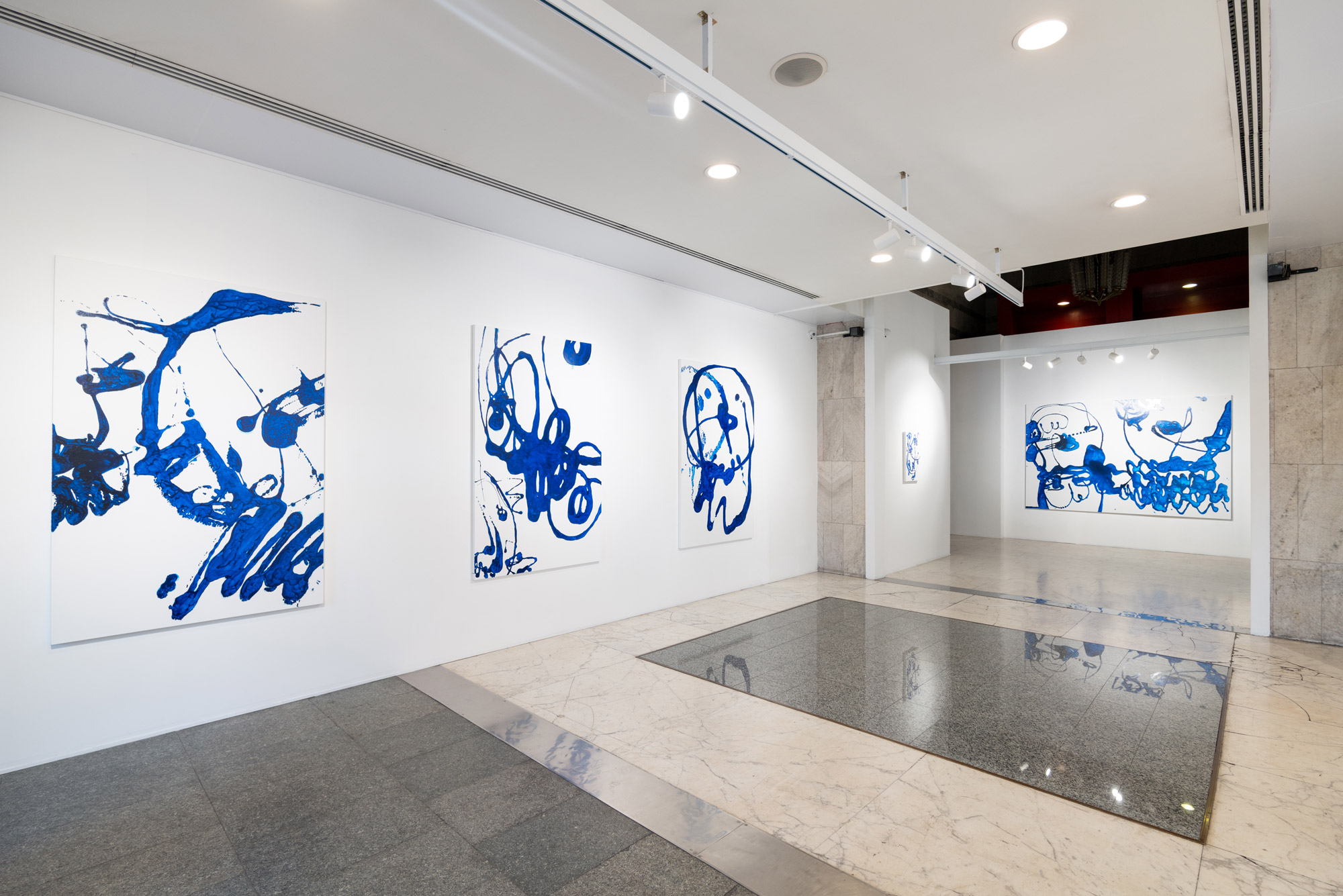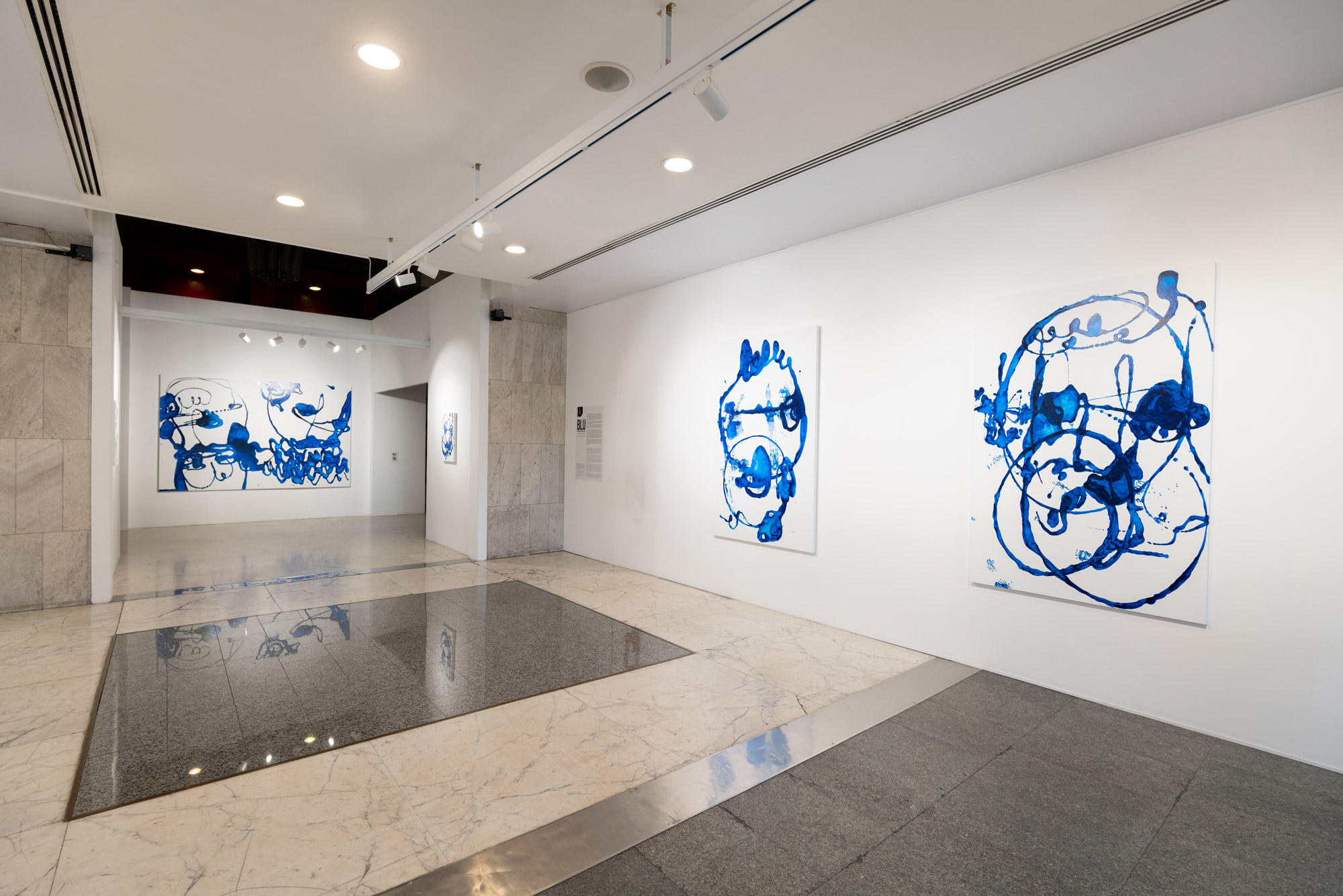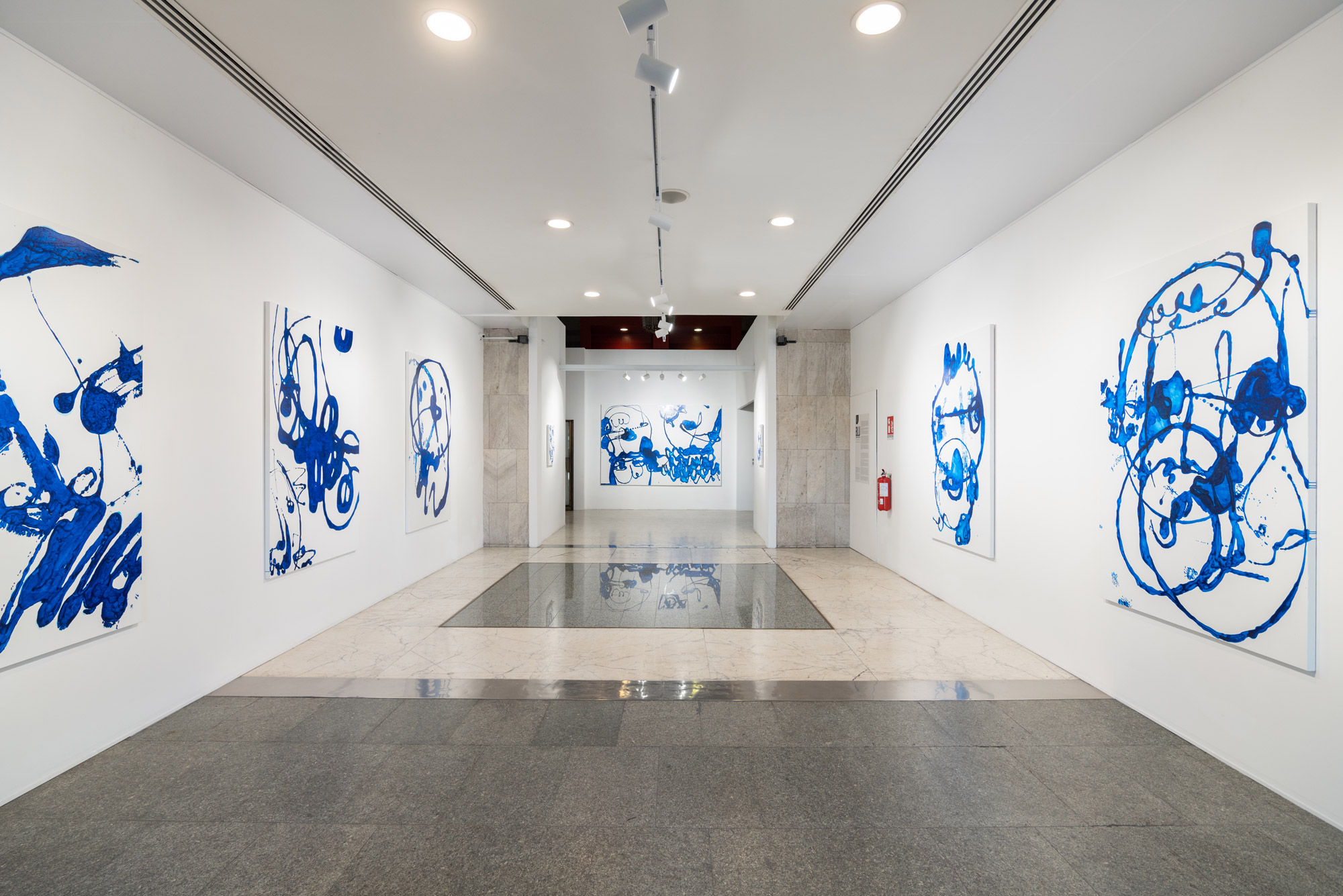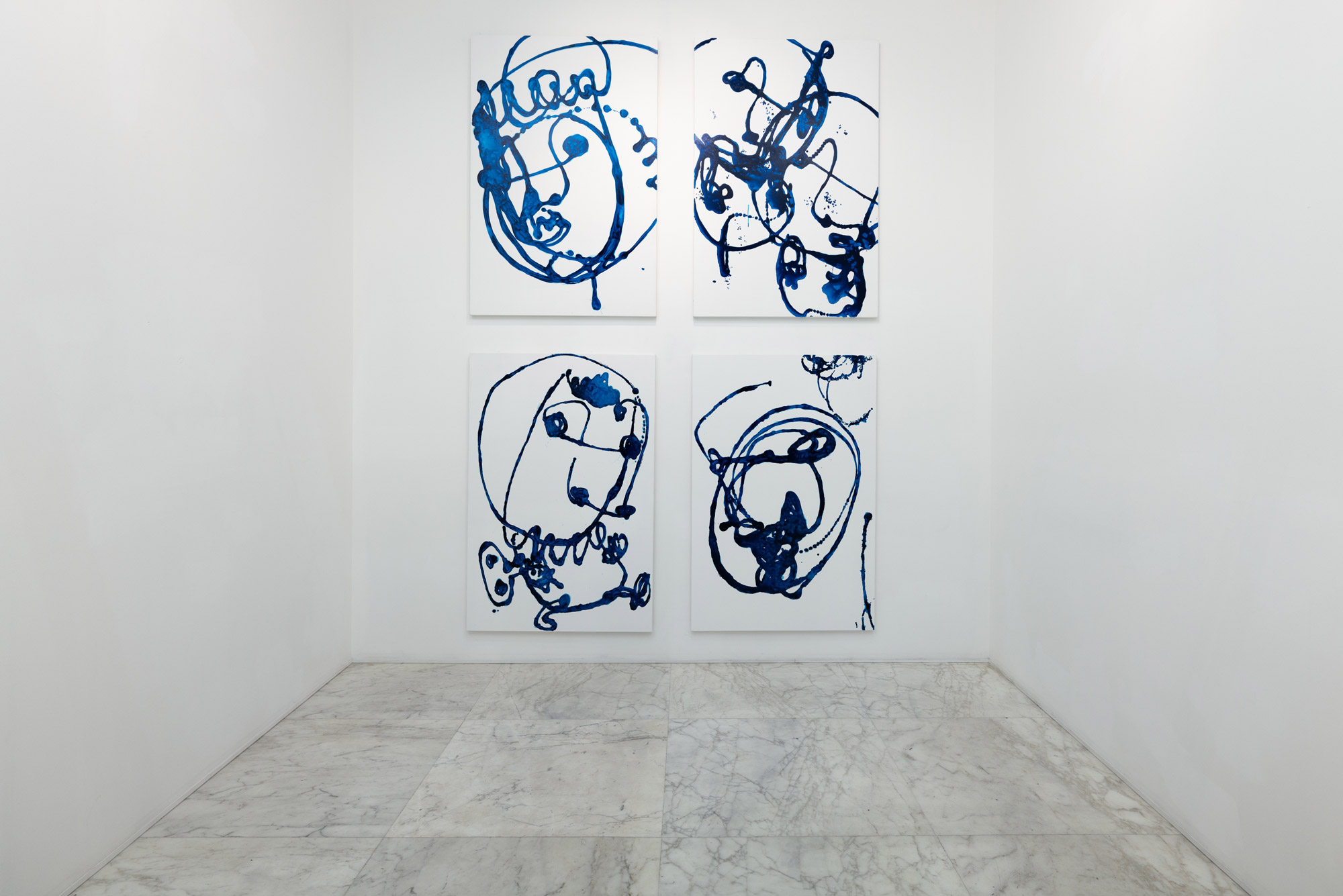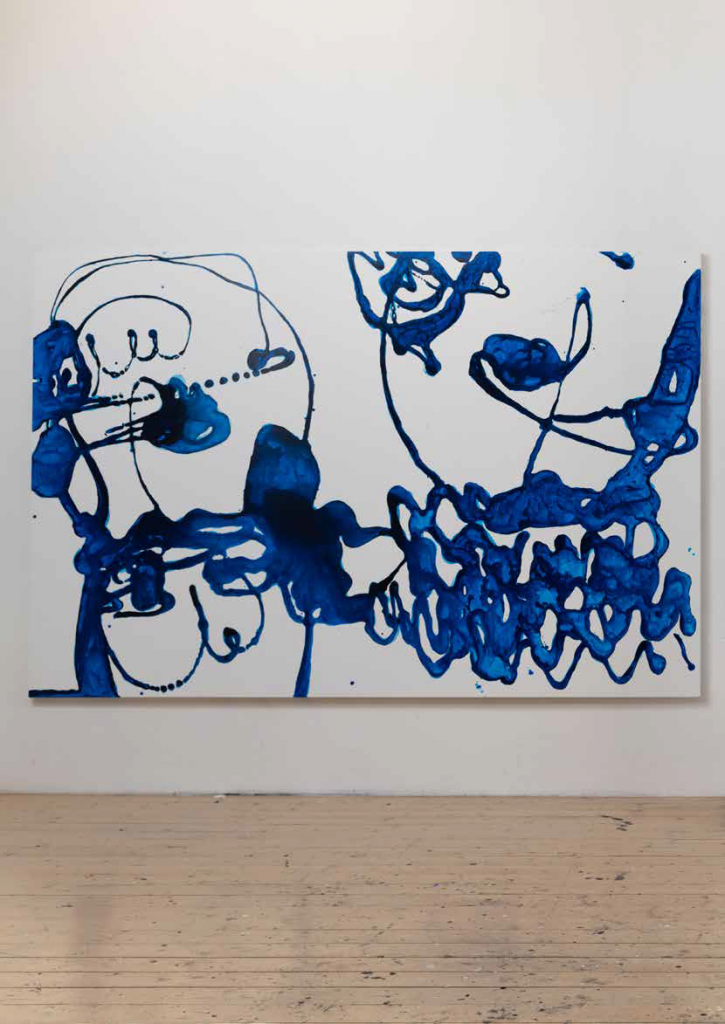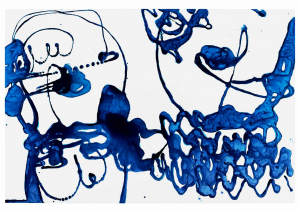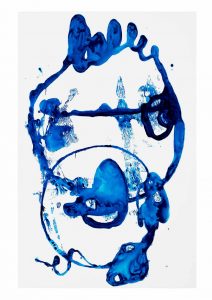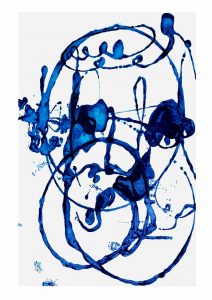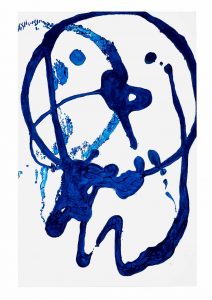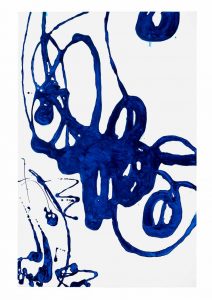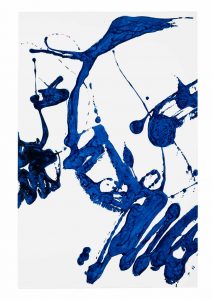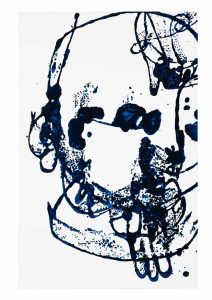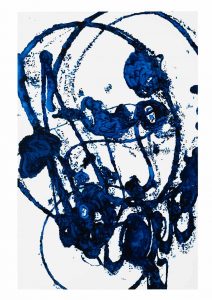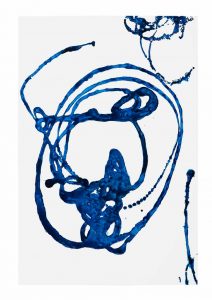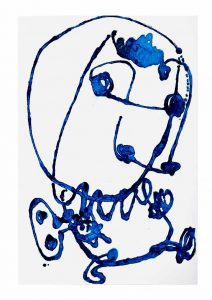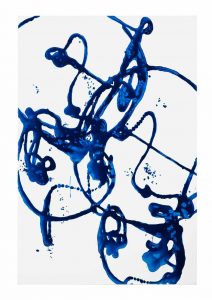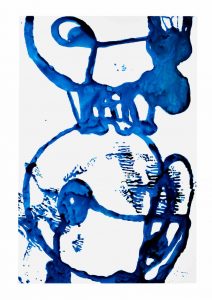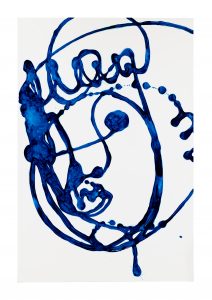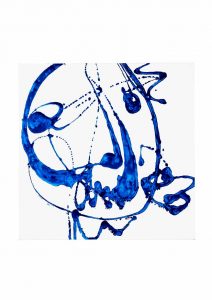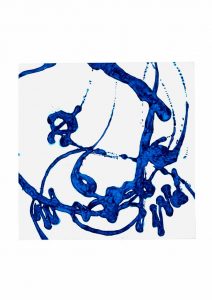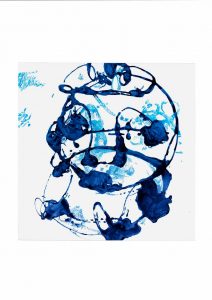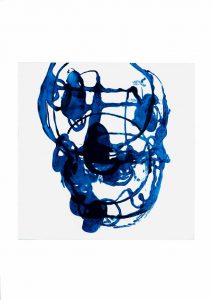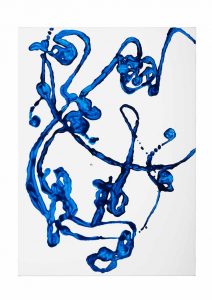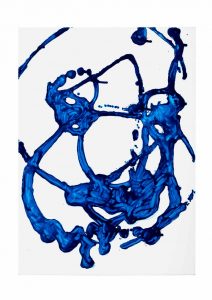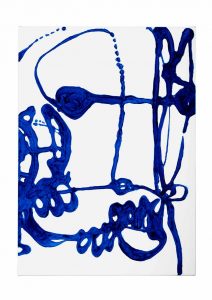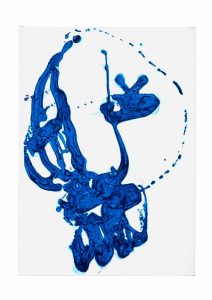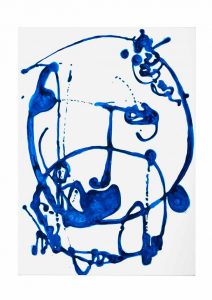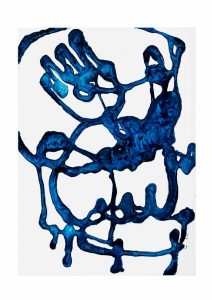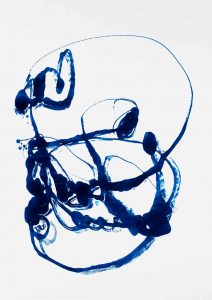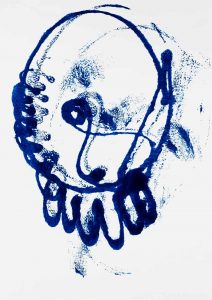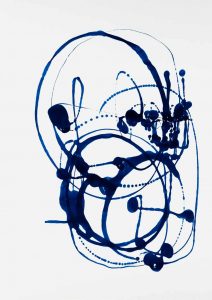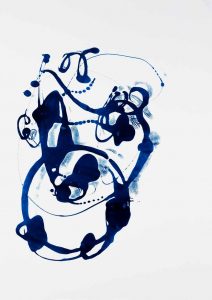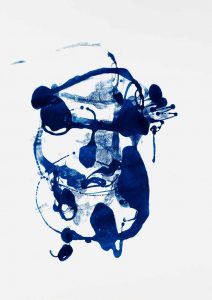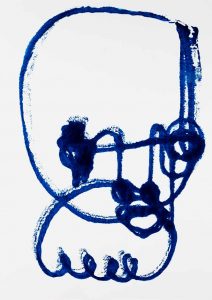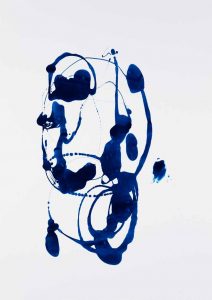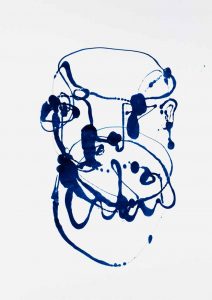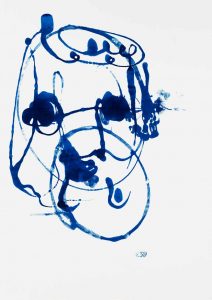2022 – BLU – Visionarea art space – Rome
BLU
Gianluca Marziani
La natura di alcuni artisti privilegia le variazioni minime su una scala semantica circoscritta. E’ un approccio dal metodo minuzioso che protegge la creazione dai “rumori” esogeni, chiudendo lo sguardo nella grammatica del proprio perimetro, senza perdita del focus sintattico, senza distrazioni tematiche che contaminerebbero l’essenza senziente dell’idea. Per questi artisti la tela si trasforma in una blindatura fortificata, un iperoggetto gravitazionale che comprime il carico energetico in forma quantistica, similmente a un campo di antimateria che esercita pressione sulla massa concentrata, al punto da moltiplicare l’energia dentro la singola tela, come se ogni atto cromatico fosse un nocciolo cosmico dotato di un codice sorgente non fungibile.
Danilo Bucchi è l’artista che più mi stimola riflessioni sul destino metafisico della pittura, sul concetto di attualità e persistenza dell’immagine dipinta, su come il quadro possa integrarsi ai nuovi profili digitali senza disperdere il suo patrimonio iconografico, la sua natura metodica e artigianale, il suo
spazio di privilegio in un mercato dalle trasformazioni endogene.
Esiste un capitalismo digitale che sta decentrando i sistemi di potere e creando piattaforme sovrapposte, fatte di arcipelaghi senza verticalismi, di processi finanziari per nuove generazioni di fruitori e acquirenti. Questo mondo ormai reale trasforma i vecchi ruoli e plasma le modalità con cui posizionare l’arte in un sistema liquido. Che non significa uccidere la pittura e i linguaggi manuali, semmai implica spostamenti nella gestione dell’opera, nel modulare gli input e output del quadro, nelle integrazioni cognitive tra grammatica analogica e sintassi digitale. Bucchi credo continuerà a dipingere per molto tempo, e lo farà nel mantenimento strategico delle proprie variazioni minime, dentro un ciclo gestuale che alimenterà la propria teoretica della pittura. Al contempo, le sue
dotazioni semantiche possiedono lo spillover linguistico, quel salto di categoria che lega un esoscheletro digitale al ciclo generativo della manualità. In pratica, le sottrazioni e il segno fluido di Bucchi determinano minimi spostamenti nel tempo, un’attitudine in cui l’origine manuale ingloba, senza volerlo, il
suo opposto digitale. Ciò accade per una ragione semplice: lo scheletro del disegnare a mano libera, producendo azioni di talento iconografico, corrisponde alle fondamenta del disegno nativo digitale. Questo avviene perché ogni processo informatico, dai primordi in HTML ad oggi, è stato regolato da principi antropomorfi, da una centralità dell’umano che ha creato, ad immagine e somiglianza del disegno libero, la prima grammatica digitale per le arti native.
Subito mi vengono in mente le “Variazioni Goldberg” di Johann Sebastian Bach, ad oggi il miglior esempio per comprendere il movimento ideale tra un archetipo (manualità)e i suoi sviluppi (digitale). L’opera musicale è un’architettura modulare di 32 brani, disposti secondo simmetrie rigorose e schemi di origine matematica. Ricordiamo che Bach amava la filosofia e l’astronomia, e non a caso le variazioni sembrano schemi terrestri che si mescolano a risonanze cosmiche ed echi esoterici. Manualità e digitale hanno le stesse corrispondenze che notiamo nel sistema sonoro di Bach, due condizioni d’ingaggio linguistico che cercano appartenenza e reciproca empatia, proprio come avviene con i tappeti sonori di un compositore che già conteneva, senza saperlo, il destino futuro
della musica elettronica.
Mi viene da affermare che la pittura rimarrà il linguaggio più innovativo e veggente dello scibile creativo. Il suo ecosistema contiene la strategia di adattamento agli habitat momentanei, identificando ogni volta obiettivi e mezzi opportuni per il raggiungimento del risultato. Ciò mi convince a scommettere sul rinnovamento della pittura dentro il canone stesso del quadro, una partenogenesi continua che metabolizzerà i flussi del progresso. Il canone in questione si chiama DISEGNO e il suo codice genetico produce filamenti digitali che ne ampliano la portata spaziotemporale. Bucchi, in un panorama che omologa per adesioni al progresso, sceglie la via opposta e parla di riduzione dentro l’unicum delle variazioni minime, cucendo assieme l’esplicito dispiegarsi della
pittura col substrato implicito del suo doppio digitale (il nostro artista potrebbe anche non realizzare mai un quadro digitale, ciò che conta è la valenza del potenziale dentro la traccia dell’evidenza).
Ogni quadro è la trascrizione di un codice chiuso, personale, non fungibile per natura. Le opere false, le stesse che hanno sospinto il mercato verso le sicurezze tracciabili degli NFT, riguardano gli incidenti di mercato, non certo la perdita di sostanza del quadro originale. Perché dentro il canone del
disegno esiste il codice genetico di un tratto non replicabile, esiste l’anima cognitiva che trasmette dati nel gesto, esiste una linea ottica che riguarda solo l’autore. La pittura rimane l’unicum non replicabile che dà sostanza al principio di unicità, preziosità, esclusività. Un codice sorgente che si ciba
di segni, materia, gesti, colore, superfici… Un codice che oggi si libra nel blu, dipinto col blu. Il blu di Danilo Bucchi.
In anteprima per VISIONAREA presentiamo le opere pittoriche del ciclo BLU. Tele di grande formato per narrare una novità sostanziale verso un colore ad alta caratura simbolica, elaborato con la consueta e meticolosa attenzione al rituale cromatico, al suo incidersi sul bianco netto dei fondali. Una coscienza gestuale che affronta il ritmo e gli equilibri del segno, captando valenze liquide che solo il blu intuisce e sostiene con empatia mediterranea, muovendosi tra le astrazioni del cielo e le brillantezze cristalline dell’acqua, aggiungendo la misteriosa coscienza minerale del blu, alchemico nel suo moto instabile delle valenze tonali, delle profondità gemmologiche, dei giochi luministici.
Forme in blu che diventano corpi autobiografici di un diario senza date.
Corpi che incarnano le astrazioni liquide di un rituale nel bianco cosmico della galassia interiore.
Disegni fluenti e viscosi, apparizioni nella geografia del pieno siderale.
Disegni elettrici nel sistema cognitivo di un pensiero fetale della pittura.
La mostra avvolge il pubblico con le sue forme fecondate da un blu irradiante e scivoloso. I corpi di Bucchi sono sempre più diluiti, come se anelassero un ritorno alle origini arcaiche del graffito, alle radici da cui il segno iniziò a narrare storie condivise. Quei segni sul bianco sono la filiazione continua di un artista che genera forme embrionali e motorie, immerse nel loro piano emotivo e sentimentale, specchio diaristico del mondo interiore che diventa racconto condiviso.
Bucchi è un artista che affronta il rituale metafisico della pittura, scavando nel rumore sottile dei dettagli, nel muoversi lentamente dentro il segno embrionale, con una frequenza ascetica che scava nella singolarità dell’azione figurativa, orientando le asana muscolari del gesto netto davanti al bianco di una geografia senza margini. Il rito di Bucchi è controllato, metodico fino alla scarnificazione, come fosse il movimento rallentato di una spada che fende l’aria. Il risultato pittorico ha somiglianze non banali con le regole dell’aikidō, l’arte marziale in cui corpo e spada diventano un medesimo volume plastico e muscolare. Quel muovere la mano tra velocità e controllo crea forme che includono il caso immaginato ed escludono ogni ipotesi di casualità. La vertigine
grafologica è la stessa di un ideogramma orientale, dove la mano agisce come una katana e il risultato solca la terra del bianco con incisioni profonde e fluviali, così simili a corsi d’acqua che divengono tracce di corpi autobiografici.
Dopo aver affrontato la lunga respirazione del segno nero su fondali bianchi, dopo aver inserito frangenti arteriosi di rosso tra le tramature dei segni neri, dopo aver affondato lo sguardo nel nero totale, Danilo Bucchi ritrova oggi la geografia del bianco su cui scorrono i fiumi del suo nuovo gemello
cromatico: un blu minerale e boreale, scivoloso tra anse che si allargano e stringono, tra rivoli che schizzano e compattano la densità cromatica, tra curvature elastiche che ci fanno pensare al Pianeta visto dal cielo ma anche al microcosmo che l’occhio nudo non percepisce.
Danilo Bucchi si conferma un serio unicum nell’attuale panorama pittorico. La sua identità iconografica lo colloca in un limbo che ibrida la figurazione nel suo opposto e viceversa. Non esiste una lettura diretta e univoca del suo universo liquido, semmai ci si muove per slittamenti e somiglianze, dentro un contesto semantico che si identifica nel proprio stilema estetico, esaltando un processo autoreferenziale che è da sempre lo scopo ultimo della grande pittura, ovvero, la creazione di un proprio mondo che si dispieghi nei codici esegetici di uno sguardo
divinatorio.
On a defined semantic scale, some artists privilege the lowest variations by nature. It is a careful methodological approach that protects the creation from external “noises” by enclosing the gaze into the grammatic of its own perimeter. It preserves the syntactical focus, without distractions that could contaminate the sentient essence of the idea. For these artists, the painting becomes a fortified armor, a gravitational hyper-object that compress the energy load quantumly. It
is similar to an antimatter field that pushes on the concentrated mass until multiplicate the energy inside the single painting, as if every chromatic action was a cosmic core equipped with an irreplaceable source code.
Danilo Bucchi is the artist that the most inspires reflections on the metaphysical destiny of the painting, on the concept of modernity and persistence of the painted image, on how the painting can integrate in new digital profiles without dispersing its iconographical heritage, its methodical and handcrafted nature, its
privileged space in a market of endogenous transformations.
It exists a digital capitalism that is decentralizing the power’s systems, creating overlapped platforms composed of archipelagos without verticalisms and financial processes for new generations of users and buyers. This already real world changes the old roles, creating the ways to place the art in a liquid system. It is not about killing the painting and the manual languages, but it rather causes movements when managing the opera, when modulating the inputs and the outputs of the painting in the cognitive integrations between analogical grammar and digital syntaxis. In my opinion, Bucchi will continue to paint for a long and he will do it maintaining his minimum strategical variations inside an action cycle that will feed his own theoretical vision of the painting. At the same time, his semantic abilities have the linguistic spillover, a qualitative leap that connects a digital exoskeleton to the generative cycle of the manual skills. In practice, the subtractions and the fluid mark of Bucchi determine some minimum movements over time and, in this attitude, the manual origin unwittingly includes its digital opposite. This happens for a simple reason: the act of drawing freehand produces actions of iconographic skill, and corresponds with the basis of the digital native drawing. This happens because every informatic process, from the early HTML to date, was regulated by anthropomorphic principles, by a centrality of the human being that it created, in the image and likeness of the free painting, the first digital grammar for the native arts.
I immediately think about the “Goldberg Variations”, of Johann Sebastian Bach, the current best example to understand the ideal movement between an archetype (manual skill) and its developments (digital). The musical work is a modular design composed of 32 tracks, organized according to accurate symmetries and mathematical schemes. We should mention that Bach loved philosophy and astronomy and, by no coincidence, the variations seem to be terrestrial schemes that mix with cosmic resonances and esoteric echoes. Manual skills and digital coincide with the Bach’s sound system. They are two conditions of the linguistic use that looks for sense of belonging and mutual empathy, just like the music carpet of a compositor that, without knowing, already contained the destiny of the electronic music.
In my opinion, the painting will always be the most innovative and prophetical language of the creative knowledge. Its ecosystem contains the adaptation strategy for temporary habitats, always identifying targets and appropriate tools to reach that goal. For this reason, I bet the renovation of the painting into the same standard of the picture, a continuous parthenogenesis that will metabolize the flows of the progress. This standard is called DRAWING and its genetic code produces digital fibers that increase its spatiotemporal load. In a scenario that conforms with the progress, Bucchi chooses the opposite side and talks about reducing the uniqueness of the minimum variations, combining the clear revealing of the painting with the implicit substratum of his digital duplicate (the artist
can even no realize a digital painting but what matters is the value of the potential inside the track of the evidence).
Every painting is the transcription of a closed, personal code, that is non-fungible for nature. The imitations that pushed the market to the traceable awareness of the NFTs concern the incidents of the market, not the loss of essence of the original painting. Because inside the painting standards, it exists the genetic code
of a non-replicable line. It exists the cognitive soul that passes down the data of the gesture and the optic line of the author. The painting is still the not replicable uniqueness that feed the principle of distinctiveness, preciousness, exclusivity. A source code that feed itself with signs, matter, acts, color, surfaces… A code
that, nowadays, soars into the blue, painted in blue. The Danilo Bucchi’s blue.
There will be a preview, for VISIONAREA, of the painting cycle BLU. Major paintings that tell a significant innovation towards a deeply symbolic color, elaborated by paying a usual and accurate attention to the chromatic ritual and its engravings on the clear white of the bottom. A gestural conscience that deals with the rhythm and the balance of the scratch, catching liquid valences that only the blue can grasp and support with Mediterranean empathy. It moves through the abstractions of the sky and the crystalline brilliance of the water. It adds the mysterious mineral conscience of the alchemic blue with its unstable motion of the tonal valences, the gemological depths and the Luminist plays.
Blue forms that become autobiographical bodies of a timeless diary. Bodies that represent the liquid abstractions of a ritual in the cosmic white of the interior galaxy. Flowing and viscous paintings, appearances in the geography of the sidereal peak. Electric paintings in the cognitive system of a fetal thought of the painting.
The exhibition involves the audience thanks to its shapes, brought out by a shining and smooth blue. The Bucchi’s bodies are more and more diluted, as if to turn back to the archaic origin of graffiti, to the roots from which the scratch started to tell shared stories. That scratches on the white are the continuous filiation of
an artist who creates embryonic and motoric shapes, absorbed into their emotional and sentimental level, a diary mirror of the interior world that becomes a shared story.
Bucchi is an artist that faces the metaphysical ritual of the painting. He reveals the light sound of the details, the slow movement towards the embryonic sign. He uses an ascetic frequency that brings the figurative action out and guides the muscular asanas of the clear gesture in front of the white of a geography without margins. The Bucchi’s ritual is controlled, methodic up to scarification, like a sword that splits the air and slows down the movement. The pictorial result is really similar to the aikidō’s rules, the martial art where body and sword become the same muscular and plastic essence. The hand moves balancing speed and control,
creating shapes that include every theory of randomness. The graphological vertigo is like an oriental ideogram, where the hand acts like a katana and the result cuts through the ground of the white with deep and river engravings, so similar to rivers becoming traces of autobiographical bodies.
After facing the long breathing of the black scratch on the white bottoms, after introducing red arterial details among the fluctuations of the black marks, after looking at the total black, Danilo Bucchi finds again the geography of the white where the rivers of his chromatic twin flow: a mineral and boreal blue which slides
among the bights that broaden and shrink, among rivulets that spurt and compact the chromatic density, among elastic curves that remember the Planet from the sky but also the microcosm, invisible with the naked eye.
Danilo Bucchi proved himself to be a real uniqueness in the current pictorial scenery. His iconographic identity put him in a limbo that hybridizes the representation of his opposite and vice versa. In his liquid universe, the interpretation is not direct or univocal. It moves by slides or similarities in a semantic
context that identifies itself in its own aesthetic writing style, highlighting a self-referential process which always was the last objective of the great painting. In other worlds, it is the creation of an own world that spreads out in the exegetical codes of a divinatory look.
- BLU1_2021_enamel on canvas_200x130 cm
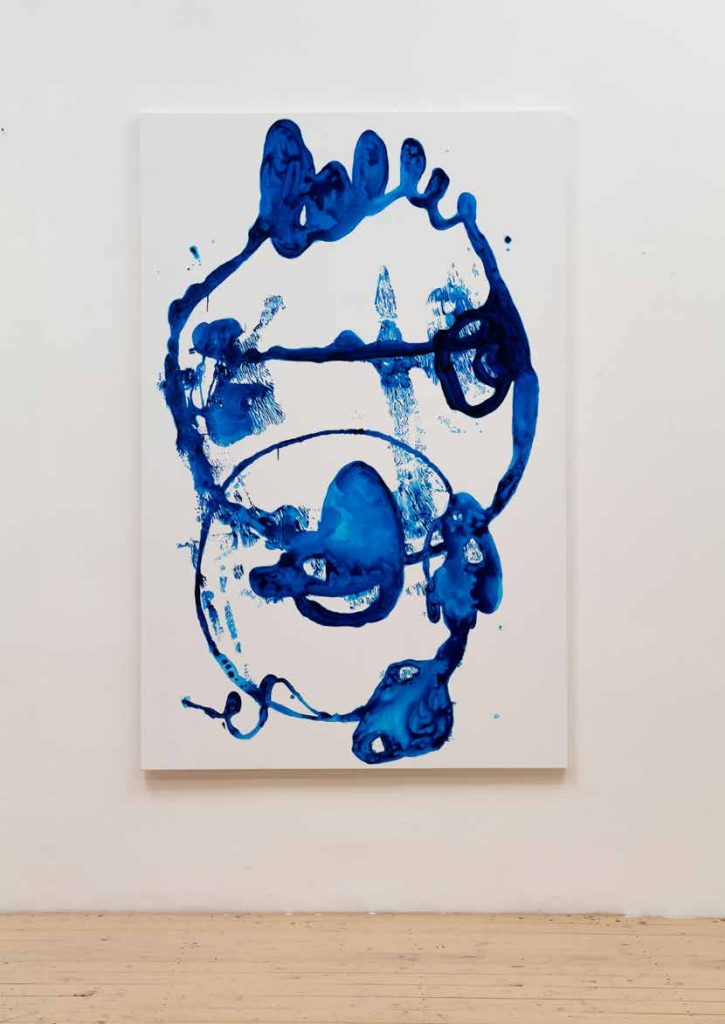
- BLU2_2021_enamel on canvas_200x130 cm
- BLU3_2021_enamel on canvas_200x130 cm
- BLU4_2021_enamel on canvas_200x130 cm
- BLU5_2021_enamel on canvas_200x130 cm
- BLU6_2021_enamel on canvas_200x130 cm
- BLU7_2021_enamel on canvas_200x130 cm
- BLU8_2021_enamel on canvas_200x130 cm
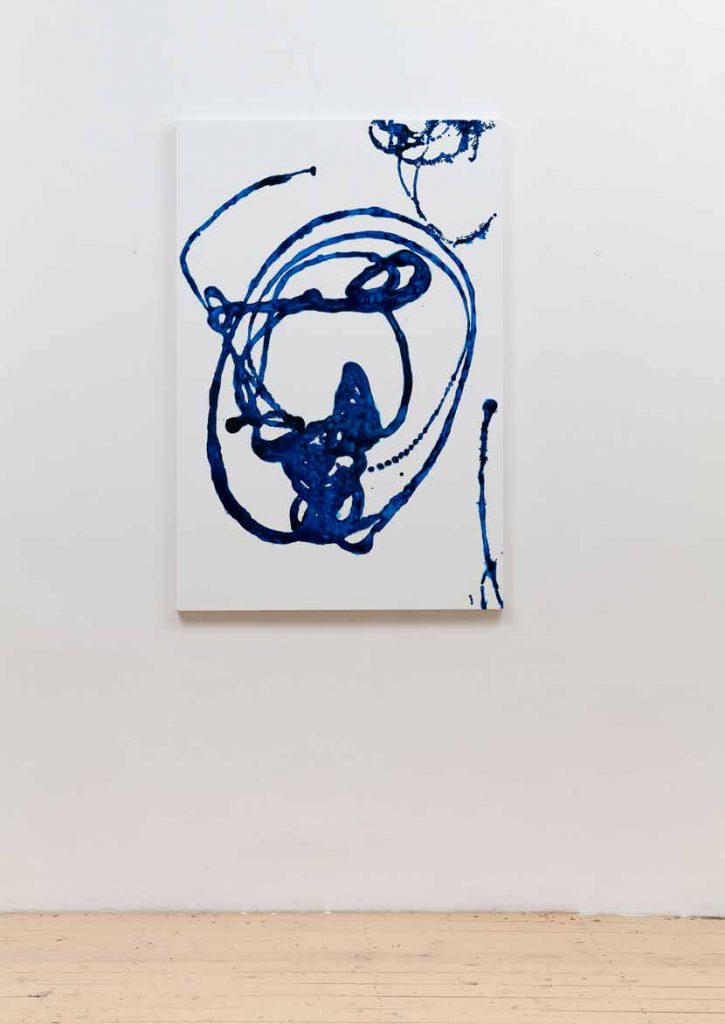
- BLU9_2021_enamel on canvas_1500x100 cm
- BLU10_2021_enamel on canvas_1500x100 cm
- BLU11_2021_enamel on canvas_1500x100 cm
- BLU12_2021_enamel on canvas_1500x100 cm
- BLU13_2021_enamel on canvas_1500x100 cm
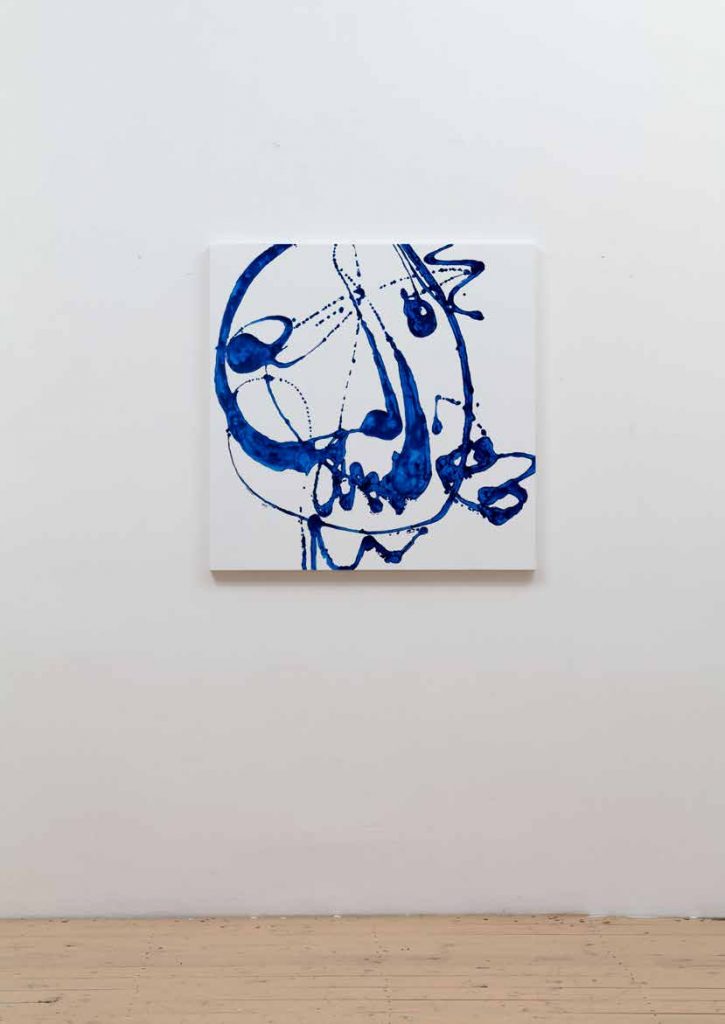
- BLU14_2021_enamel on canvas_100x100 cm
- BLU15_2021_enamel on canvas_100x100 cm
- BLU16_2021_enamel on canvas_100x100 cm
- BLU17_2021_enamel on canvas_100x100 cm
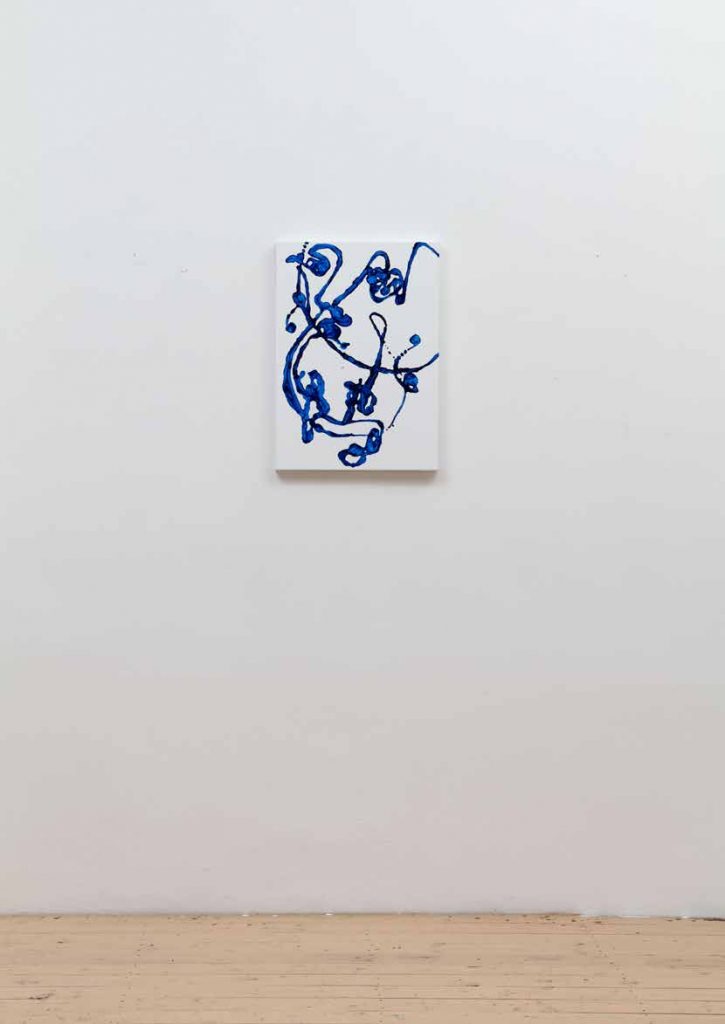
- BLU19_2021_enamel on canvas_70x50 cm
- BLU20_2021_enamel on canvas_70x50 cm
- BLU21_2021_enamel on canvas_70x50 cm
- BLU22_2021_enamel on canvas_70x50 cm
- BLU23_2021_enamel on canvas_70x50 cm
- BLU24_2021_enamel on canvas_70x50 cm
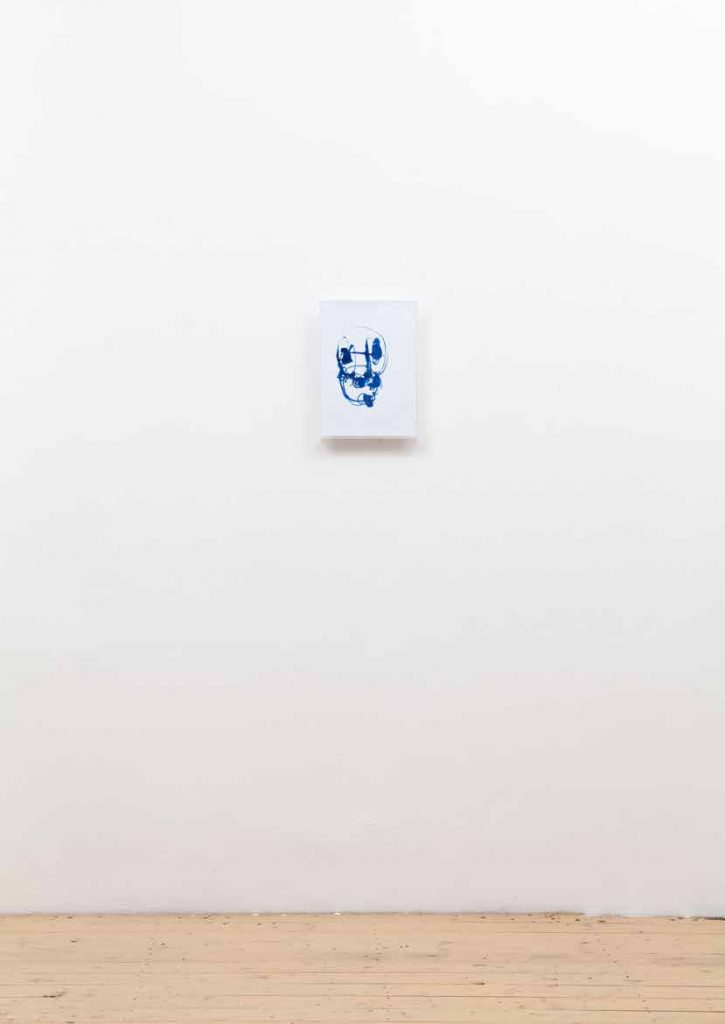
- BLU25_2021_enamel on canvas_43x30,5
- BLU26_2021_enamel on canvas_43x30,5
- BLU27_2021_enamel on canvas_43x30,5
- BLU28_2021_enamel on canvas_43x30,5
- BLU29_2021_enamel on canvas_43x30,5
- BLU30_2021_enamel on canvas_43x30,5
- BLU31_2021_enamel on canvas_43x30,5
- BLU32_2021_enamel on canvas_43x30,5
- BLU33_2021_enamel on canvas_43x30,5

